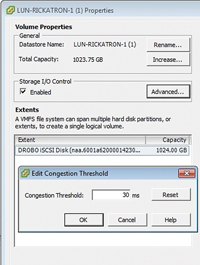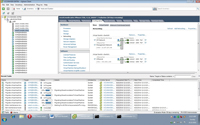vSphere 4.1 Packs an Incremental Punch
The VMware update to vSphere boasts an amazing number of improvements and new features.
- By Rick Vanover
- 11/01/2010
Like its vSphere 4.0 predecessor, which debuted with a slew of new features barely a year ago, vSphere 4.1 includes a mix of new features and enhancements. These offerings are broken down evenly across many areas of a vSphere installation. Here are a few configuration notes for the features that infrastructure administrators will find most attractive:
vStorage APIs for Array Integration (VAAI): This feature set is now in its infancy, but has great potential for helping enterprise storage systems make easy work of selected vSphere I/O operations. The current list of hardware vendors that support VAAI is short, and within that short list the number of actual products shipping is even smaller. VAAI gives the decision maker an opportunity to deliver a storage solution that's much more aligned to the I/O needs of a virtualized environment by optimizing repetitive functions at the storage processor, rather than the hypervisor.
Storage I/O Control (SIOC): This new feature is designed to help address the No. 1 performance issue that virtualization administrators face: slow storage. While virtualization doesn't fix underperforming storage, SIOC allows administrators to apply share-based prioritization to storage resources. Effectively Distributed Resource Scheduling (DRS) for a datastore, SIOC enforces the I/O shares across all virtual machines (VMs) that access a datastore.
SIOC establishes a latency value for each datastore. The default value is 30 ms, which is rather generous. There's no default latency value that will work for every environment, as everyone's requirements vary. Within many virtualization circles, 20 ms latency is the threshold where administrators start to become concerned. When latency on the datastore exceeds the threshold value, SIOC assigns disk access based on the share value of the VMs on that datastore. Like other share functions, configurations can get complicated. A generally accepted practice is sticking with the default share values of high, normal or low when assigning resource allocations for VMs, and staying away from directly entering a shares value.
SIOC is different from other DRS-like features in that it flows from the datastore to the VMs. SIOC is not based on the aggregated resources of the cluster, but instead on the individual datastore object. The silver lining is that individual datastores are configured for SIOC, so administrators can prioritize where prioritization is needed. Figure 1 shows the SIOC configuration window.

[Click on image for larger view.] |
| Figure 1. The SIOC configuration screen allows a latency congestion threshold value to be set for each datastore. |
SIOC only works with Virtual Machine File System (VMFS) volumes, confirming a long-standing opinion that VMFS is the first in line for new features. Network File System (NFS)-based storage systems currently do not support SIOC.
Network I/O Control (NIOC): Much like SIOC, the new NIOC feature allows advanced prioritization of network traffic groups that are using a vSphere vNetwork Distributed Switch. The traffic groups include FT VM traffic, iSCSI traffic, vMotion traffic, management traffic, NFS traffic and guest VM traffic. This categorization is important as Ethernet-based storage protocols (iSCSI and NFS) become more popular in virtualized infrastructures. NIOC can help protect investments by reducing port costs, as well as by giving the administrator granular control of the network interfaces. Network throughput is usually not one of the bottlenecks for most virtualization installations, but NIOC is one step ahead of the problem.
ESXi Host Authentication: Any admin will welcome a configuration that delivers a unified identity management solution. vSphere 4.1 introduces Active Directory-integrated authentication to ESXi hosts. This is similar to what XenServer 5.5 does, in that a computer account for the ESXi host is created in the AD domain. Most access to the hosts is performed via vCenter, but anything that reduces the frequency of root logging in will be welcome. This feature is also available on the free ESXi installation, now dubbed VMware vSphere Hypervisor.
Scaling Improvements: vSphere has increased its management capacity in a number of areas. For example, a high-availability cluster can now scale to the same limit as a DRS cluster. A smattering of concurrent activity increases have been added, including the number of concurrent vSphere client connections. Likely the most beneficial to infrastructure administrators is the increase in number of concurrent vMotion operations per host. The supported limit is now eight current vMotion operations for 10 Gigabit networks, and four for 1 Gigabit networks. Figure 2 shows this in action.
These updates pose a minimal learning curve in the UI or day-to-day tasks that make up a typical installation. One new feature that the everyday administrator will appreciate is the DRS Resource Distribution chart. This quick and easy chart shows how the workloads are balanced across servers for CPU and memory resources. Previously, administrators looked in a number of places to determine the cluster balance.
For highly consolidated workloads, vSphere 4.1 introduces an expanded category of functionality for its memory management technology suite in memory-compression technology. This is a meet-in-the-middle solution between hypervisor swapping and the more desirable technologies of transparent page sharing and balloon drivers. Memory compression won't magically let you cram more workloads into existing infrastructure investments -- a single-digit percentage gain in efficiency is more realistic.

[Click on image for larger view.] |
| Figure 2. vCenter will now manage four or eight simultaneous vMotion events per host. |
Be Sure to Course-Correct
One of the fundamental principles of virtualization that makes the lives of administrators easier is the ability to change configurations with ease. Whether it's a new server model functioning as host hardware, a new storage array or even the move from ESX to ESXi, vSphere continues to be flexible by making short work of the tasks through native functionality. The ESX vs. ESXi decision is now clear as vSphere 4.1 is the last release of the ESX hypervisor. ESXi will be the hypervisor for subsequent versions of vSphere.
The push to ESXi and x64 is the hidden homework behind all of these vSphere 4.1 features, but most of the changes won't be as earth-shattering as they appear. In fact, many of the elements are made easy by tools provided with vSphere. The Data Migration Tool, for example, allows a vCenter Server configuration to be moved from an x86 platform to an x64 vCenter Server with a SQL Express database running locally on the system.
The Efficiency Factor
The tools are available with vSphere to push more out of your infrastructure investment. There are scores more features that simply won't fit in this quick review of vSphere 4.1. Efficiency will be the distinguishing factor between one IT operation and another. Consider that everyone is effectively purchasing the same equipment and software; the difference maker will be the efficiency of configuration and operations. Without mentioning cloud, it's clear that an efficiently configured and well-operating virtualized infrastructure is the gateway to greater things.
About the Author
Rick Vanover (Cisco Champion, Microsoft MVP, VMware vExpert) is based in Columbus, Ohio. Vanover's experience includes systems administration and IT management, with virtualization, cloud and storage technologies being the central theme of his career recently. Follow him on Twitter @RickVanover.